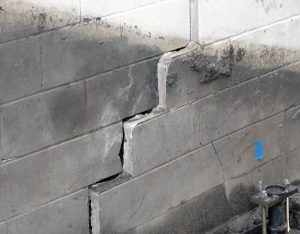The foundation of your home serves as the backbone of its structural integrity, providing support and stability to the entire building. However, when cracks develop in the foundation, particularly in the basement, it can be a cause for concern. In this article, we’ll explore the causes of foundation cracks in your basement, the potential risks they pose, and the various solutions available to homeowners facing this common issue.
Understanding Foundation Cracks:
Foundation cracks can manifest in various forms, sizes, and locations within a basement. While some cracks may be superficial and pose minimal risk, others can indicate underlying structural issues that require immediate attention. Here are some common types of foundation cracks found in basements:
- Vertical Cracks: Vertical cracks run straight up and down and are often caused by settling or shrinking of the foundation. While small vertical cracks may be cosmetic, larger or widening cracks can indicate more significant structural movement.
- Horizontal Cracks: Horizontal cracks typically indicate lateral pressure exerted on the foundation walls, such as from soil expansion or hydrostatic pressure. These cracks can compromise the integrity of the foundation and may require prompt repairs to prevent further damage.
- Diagonal Cracks: Diagonal cracks can occur at an angle and may be indicative of differential settlement or shifting of the foundation. These cracks can widen over time and may signal structural instability if left unaddressed.
- Stair-Step Cracks: Stair-step cracks follow a diagonal pattern and often occur in masonry or block foundations. These cracks may be caused by soil movement, foundation settling, or lateral pressure and can indicate significant structural issues.
- Hairline Cracks: Hairline cracks are small, thin cracks that may appear superficial but can widen over time, especially if left untreated. While hairline cracks may not pose an immediate threat, they can allow moisture infiltration and should be monitored closely.
Causes of Foundation Cracks in Basements:
Several factors can contribute to the development of foundation cracks in basements, including:
- Soil Movement: Changes in soil moisture levels, soil composition, and soil settlement can exert pressure on the foundation walls, leading to cracks.
- Hydrostatic Pressure: Excessive groundwater pressure against the foundation walls, especially during periods of heavy rainfall or snowmelt, can cause horizontal or stair-step cracks.
- Poor Drainage: Inadequate drainage around the foundation, such as clogged gutters, improper grading, or ineffective waterproofing, can contribute to water infiltration and foundation damage.
- Freeze-Thaw Cycles: Frost heave resulting from freeze-thaw cycles can exert pressure on the foundation walls, leading to cracking and structural movement.
- Structural Movement: Settlement, shrinkage, or expansion of building materials, such as concrete or masonry, can result in foundation cracks over time.
Risks Associated with Foundation Cracks:
Foundation cracks in basements can pose various risks to the structural integrity, safety, and value of a home, including:
- Water Intrusion: Foundation cracks can allow water infiltration into the basement, leading to moisture problems, mold growth, and water damage to belongings and structural components.
- Structural Instability: Significant foundation cracks can compromise the stability of the entire structure, leading to uneven floors, sticking doors or windows, and potential collapse in severe cases.
- Reduced Property Value: Foundation issues, including visible cracks, can detract from the curb appeal and resale value of a home, making it less attractive to potential buyers.
- Health Hazards: Moisture infiltration resulting from foundation cracks can create a conducive environment for mold, mildew, and bacteria, posing health risks to occupants, especially those with respiratory conditions.
- Safety Concerns: Foundation cracks can weaken the structural integrity of the basement walls, posing safety hazards to occupants and increasing the risk of injury or property damage.
Solutions for Addressing Foundation Cracks:
When faced with foundation cracks in the basement, homeowners have several options for addressing the issue, depending on the severity and underlying cause of the cracks:
Foundation Crack Repair:
- Epoxy Injection: Epoxy injection is a common method used to repair hairline or minor cracks in concrete foundations. The process involves injecting a low-viscosity epoxy resin into the crack to fill and seal it, restoring the structural integrity of the foundation.
- Polyurethane Foam Injection: Polyurethane foam injection is another technique used to repair cracks in concrete foundations. The expanding foam fills the crack and creates a watertight seal, preventing further water infiltration and structural damage.
- Carbon Fiber Reinforcement: Carbon fiber reinforcement involves applying carbon fiber straps or plates to the foundation walls to reinforce and stabilize them, particularly in cases of horizontal or stair-step cracks.
Waterproofing and Drainage Improvement:
- Exterior Waterproofing: Exterior waterproofing involves excavating around the foundation walls, applying a waterproof membrane or coating, and installing drainage systems to redirect water away from the foundation.
- Interior Waterproofing: Interior waterproofing techniques, such as installing drainage tiles, sump pumps, and vapor barriers, can help manage groundwater and prevent water infiltration into the basement.
Foundation Underpinning and Stabilization:
- Helical Piers or Push Piers: Helical piers or push piers can be installed beneath the foundation to stabilize and support the structure, particularly in cases of settlement or shifting.
- Steel Reinforcement: Steel reinforcement methods, such as tiebacks or wall anchors, can be used to stabilize bowing or leaning foundation walls and prevent further movement.
Grading and Drainage Correction:
- Grading Improvement: Correcting grading issues around the foundation, such as sloping the soil away from the house and installing proper drainage systems, can help mitigate water infiltration and prevent future foundation cracks.
- Gutter Maintenance: Ensuring gutters and downspouts are clean, free-flowing, and properly directed away from the foundation can help prevent water pooling and hydrostatic pressure against the basement walls.
Foundation cracks in the basement are a common concern for homeowners, but they can be addressed effectively with the right solutions and professional assistance. By understanding the causes and risks of foundation cracks and implementing appropriate repair and prevention measures, homeowners can protect the structural integrity, safety, and value of their homes for years to come. If you notice foundation cracks in your basement, it’s essential to consult with qualified foundation repair experts to assess the extent of the damage and determine the most suitable course of action.
Contact the Professionals at Accurate Basement Repair Today at 414-744-6900
Distribution Links +
- https://smb.salisburypost.com
- https://smb.shelbycountyreporter.com
- https://smb.smithfieldtimes.com
- https://smb.suffolknewsherald.com
- https://smb.thewashingtondailynews.com
- https://smb.thewetumpkaherald.com
- https://smb.cordeledispatch.com
- https://smb.lagrangenews.com
- https://smb.middlesboronews.com
- https://smb.roanoke-chowannewsherald.com
- https://smb.tallasseetribune.com
- https://smb.thepostsearchlight.com
- https://smb.valleytimes-news.com
- https://smb.lowndessignal.com
- https://pr.washingtoncitypaper.com
- https://smb.theleesvilleleader.com
- https://smb.prentissheadlight.com
- https://smb.beauregardnews.com
- https://pr.hattiesburg.com
- https://pr.bradfordvillebugle.com
- https://pr.boreal.org
- https://pr.stylemg.com
- https://pr.walnutcreekmagazine.com
- https://pr.thembnews.com
- https://pr.timesofsandiego.com
- https://pr.chestercounty.com
- https://pr.wncbusiness.com
- https://pr.ashlandtownnews.com
- https://pr.franklintownnews.com
- northeast.newschannelnebraska.com
- plattevalley.newschannelnebraska.com
- panhandle.newschannelnebraska.com
- rivercountry.newschannelnebraska.com
- lifestyle.mykmlk.com
- lifestyle.3wzfm.com
- lifestyle.southernsportstoday.com
- lifestyle.thepodcastpark.com
- lifestyle.680thefan.com
- lifestyle.xtra1063.com
- lifestyle.953hlf.com
- lifestyle.rewind1019.com
- lifestyle.us983.com
- lifestyle.countrylegends1059.com
- lifestyle.967wshv.com
- lifestyle.1045thedan.com
- michigan.yournewsnet.com
- lifestyle.earl983.com
- lifestyle.maverick1023.com
- lifestyle.magic979wtrg.com
- lifestyle.1077lakefm.com
- lifestyle.kbew98country.com
- lifestyle.kccrradio.com
- lifestyle.capitalcityrock.com
- lifestyle.current943.com
- lifestyle.thedam.fm
- lifestyle.hotcountry931.com






